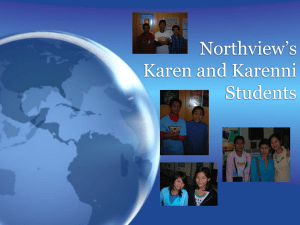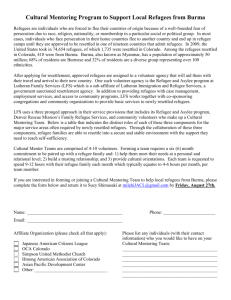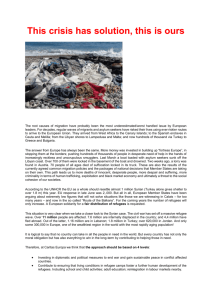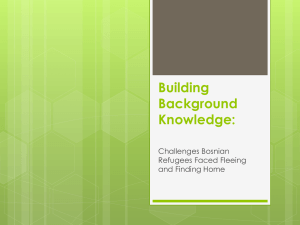Refugees from Burma
advertisement
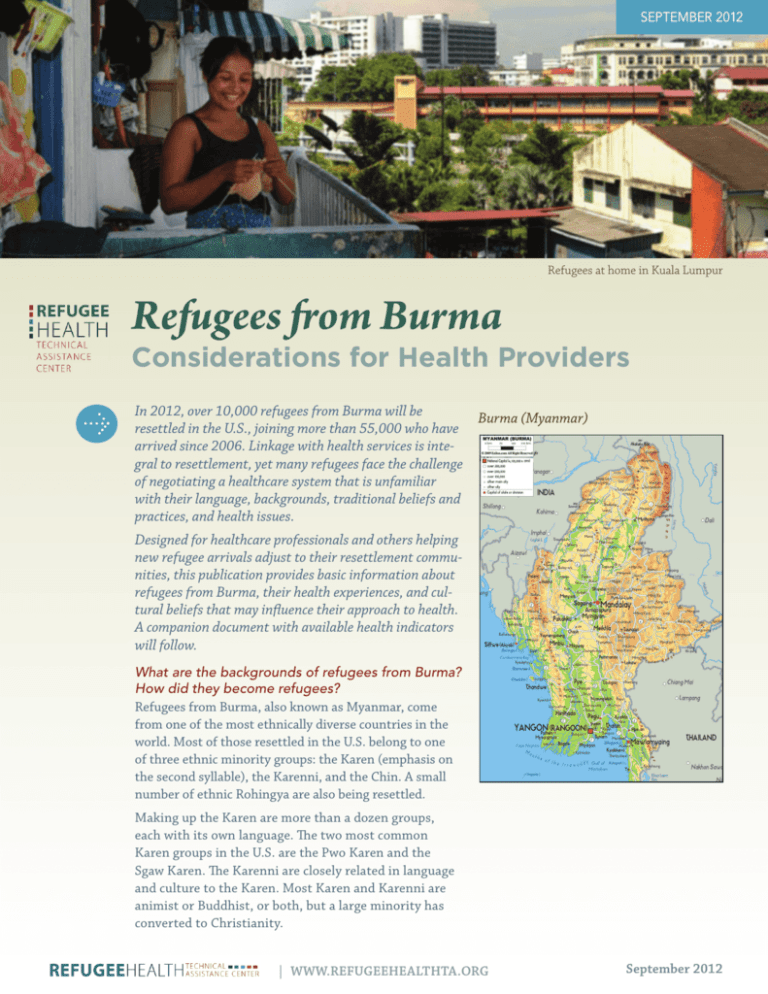
September 2012 Refugees from Burma: Considerations for Health Providers .1 Refugees at home in Kuala Lumpur Refugees from Burma Considerations for Health Providers In 2012, over 10,000 refugees from Burma will be Burma (Myanmar) resettled in the U.S., joining more than 55,000 who have arrived since 2006. Linkage with health services is integral to resettlement, yet many refugees face the challenge of negotiating a healthcare system that is unfamiliar with their language, backgrounds, traditional beliefs and practices, and health issues. Designed for healthcare professionals and others helping new refugee arrivals adjust to their resettlement communities, this publication provides basic information about refugees from Burma, their health experiences, and cultural beliefs that may influence their approach to health. A companion document with available health indicators will follow. What are the backgrounds of refugees from Burma? How did they become refugees? Refugees from Burma, also known as Myanmar, come from one of the most ethnically diverse countries in the world. Most of those resettled in the U.S. belong to one of three ethnic minority groups: the Karen (emphasis on the second syllable), the Karenni, and the Chin. A small number of ethnic Rohingya are also being resettled. Making up the Karen are more than a dozen groups, each with its own language. The two most common Karen groups in the U.S. are the Pwo Karen and the Sgaw Karen. The Karenni are closely related in language and culture to the Karen. Most Karen and Karenni are animist or Buddhist, or both, but a large minority has converted to Christianity. | www.refugeehealthta.org September 2012 Refugees from Burma: Considerations for Health Providers The Chin are also made up of different ethnic and linguistic groups. Most Chin being resettled in the U.S. are Protestant Christians. The Rohingya are a Muslim minority with their own language, also called Rohingya. The refugees fled ethnic and religious persecution in Burma for asylum in nearby countries. Before their arrival in the U.S., most Karen and Karenni refugees lived in camps in Thailand, sometimes for many years, while most Chin and Rohingya survived in Malaysia as undocumented asylum seekers. Conditions for refugees in first asylum countries are often unhealthy and unsafe. What healthcare services might refugees from Burma have received before their arrival in the U.S.? Access to professional medical care is limited in Burma, particularly in the rural, conflict-ridden areas where the refugees lived. In Thailand, most Karen refugees receive basic medical services, provided by nongovernmental organizations at refugee camps. Services include maternal and child healthcare, family planning, vaccinations, nutrition programs, and tuberculosis and HIV/AIDS treatment. Psychological counseling is rare, and dental care is scarce. Medical services for Chin and Rohingya in Malaysia are extremely limited. What traditional health beliefs and practices might we expect the refugees from Burma to bring with them? Refugees from Burma bring with them concepts of health and medicine that can be very different from common U.S. beliefs. One basic belief is that good health results from the right balance of “hot” and “cold” elements. If the body becomes too hot or too cold, certain medicines and foods Thanakha, seen on this refugee child’s cheeks, is used to cool the skin and prevent sunburn. .2 will be taken to bring the system back into balance. For example, a sudden change in the weather may cause the body to become too hot, and thanakha, a paste made from tree bark, is used to cool the skin. For refugees who hold these beliefs, the extremes of hot and cold weather in U.S. communities, and the lack of access to traditional remedies, may cause anxiety. Another important belief is that good health depends on the adequate supply of healthy blood in the body. For example, a woman’s blood level is believed to decrease during pregnancy, and therefore she will take “blood medicine” to increase the levels. For the Karen, food is closely tied to health. According to a traditional saying, “Food is medicine and medicine is food.” During sickness, certain foods are avoided, while others are used to promote healing. For example, it is believed that certain types of meat should be avoided during illness, that people with hepatitis should not eat yellow foods, and that papaya triggers malaria. Given these beliefs, health providers should discuss dietary concerns with patients when an illness is diagnosed. Are there traditional practices or common behaviors that providers should be aware of? Practices and behaviors that may be of concern include the following: • Popular Asian medicines used by refugees to treat common ailments, such as headaches and stomach pain, have been found to contain heavy metals. • A traditional blood-letting procedure, based on the belief that illness is caused by “bad blood,” is commonly performed without the use of clean instruments or disinfectant and may result in infections. • Coining and cupping, folk remedies widely used in Asia, leave marks on the body that U.S. authorities and providers may mistakenly interpret as abuse. • Muslim Rohingya patients may be unwilling to take medication or oral rehydration during the Muslim fasting period of Ramadan, even though the ill are among those whom the Koran exempts from fasting. • Men may drink alcohol, usually beer, sometimes to excess. Among the Chin in Burma, the traditional alcohol, zu, is seen as a status symbol reserved for the wealthy. Refugees in the U.S. are surprised by the easy availability of beer. • Smoking is common among refugee men. In Burma and the camps, it is not uncommon for young boys to take up smoking. Among the Chin, smoking, like alcohol, is seen as a status symbol, and many will smoke because it is considered a sign of wealth. | www.refugeehealthta.org September 2012 Refugees from Burma: Considerations for Health Providers .3 • Men and women commonly chew betel quid, a mixture of substances that may include tobacco and other ingredients harmful to health. Chin women may also use a kind of smokeless chewing tobacco. How do refugees from Burma view mental illness? Are there any traditional treatments? In general, those who are struggling with psychological issues are expected to be stoic and bear their problems without complaint, turn to religion for solace and religious leaders for advice, and get on with their lives. However, those who are seriously ill do not work and are taken care of by the family. There is little in the way of traditional treatments for the mentally ill, although some mental illnesses are thought to be due to spirit possession, and religious advisors may be brought in for ceremonies or purification rituals. In refugee communities in the U.S., community spiritual leaders— Christian pastors, Buddhist monks, or traditional healers— may play a helpful role in mental health treatment, either as cultural brokers or as counselors themselves. To what extent are domestic abuse and sexual violence issues? As in many communities, domestic abuse is an issue. Parents may use physical punishment to discipline their children. Intimate partner violence has become an issue of concern in the Thai camps, where a 2002 study found that 20% of randomly selected married women had been abused by their husbands, with 17% sustaining an injury. In contrast to some other cultures, rape victims are not ostracized, and in general are treated with sympathy. If the victim takes the steps of reporting a rape, the community may take action against the rapist, depending on the circumstances. Having been raped does not mean a woman cannot get married or that she will be blamed or punished, but if the rapist is her boyfriend she may be heavily pressured to marry him. How much experience with western medicine might we expect from refugees from Burma? What are their attitudes toward it? Most new arrivals have had at least limited exposure to western medicine, usually in first asylum countries. Most are generally open to and curious about western medicine, and appreciate explanations of the workings of both the body and medicine. Some refugees prefer traditional medicine because they believe it is more effective than western medicine, or that it is just as effective but without the negative side effects. In general, traditional medicine may be favored by those with Nu Po camp housing for refugees from Burma less exposure to western medicine – individuals from rural areas and those with less education. Many refugees from Burma have worked out a balance between traditional and western medicine, using one or the other, or a combination of the two, depending on the illness and the medicine. How much awareness of western health and wellness beliefs might we expect refugees from Burma to have? Awareness varies, depending on past exposure to western medicine and level of education, but understanding is often limited in the following areas: • Hygiene. Common knowledge about germs and their connection to illness may be limited. Education about hand, cough, and kitchen hygiene is recommended. The importance of using soap when washing hands and dishes, and not merely rinsing with water, should be emphasized. • Preventive healthcare. Most refugees are not used to seeing a health provider when they feel well. The reasoning behind physical and dental check-ups should be explained. Preventive procedures, such as pap smears, mammographies, and colonoscopies, may be unfamiliar and of lower priority than more immediate needs. • Causes of diseases. Understanding about the causes of diseases may not align with western clinical models. For example, refugees may believe that tuberculosis can be caused or spread by smoking, sharing utensils, and air pollution, or be inherited. • Symptom vs. disease. The symptom of a disease may be equated with the disease itself. As a result, some refugees may stop taking a medicine when the disease symptom disappears. Those taking medicine for chronic | www.refugeehealthta.org September 2012 Refugees from Burma: Considerations for Health Providers .4 conditions may take more on days they feel worse and miss doses when they are feeling better. • Mental illness. There are few psychiatric hospitals in Burma, and mental health services in refugee camps are scarce. As a result, few refugees are familiar with western conceptions of mental illness and treatment options. Epilepsy is often viewed as a form of mental illness. • Sexual health. Few young refugees have accurate information about sexual health or anatomy, and even those well into their 20s welcome information from health providers. Awareness of prevention and treatment of sexually transmitted infections is low. Sources This publication is based on information provided by contributing writers and informants and on the following written sources: Although premarital sex is frowned upon, a survey of young people in two Karen refugee camps found that about half of young married people have had premarital sex, and more than half of those who were married did so because their sexual relations had been discovered. Some had married as young as 14. In this cultural environment, unmarried young mothers may need extra support and encouragement to make use of prenatal care. Centers for Disease Control and Prevention, American Refugee Committee, & Médecins Sans Frontières. (2002). An assessment of reproductive health issues among Karen and Burmese refugees living in Thailand. As family planning is addressed by health organizations in the refugee camps, refugees are gradually becoming more familiar with contraception, but regular and consistent use remains quite low. Pregnancy termination is not accepted, but in Burma and first asylum countries it may be resorted to out of desperation, and is a cause of infertility and mortality. Women may first attempt to abort through traditional medicines and massage, and then resort to dangerous illegal procedures. Women may be reluctant to mention abortion, especially in front of others from their community. Although sexual issues are not discussed openly in the community, sex is not a taboo topic in a healthcare setting. Patients may be reluctant to initiate a discussion about a sexual issue with their health providers but will often appreciate the opportunity to discuss the issue once it has been raised. Conclusion: A Note of Caution This publication summarizes health issues relating to refugees from Burma as a whole, and caution should be exercised in applying the information to individual patients. Refugees from Burma are diverse, and their individual experiences, beliefs, and practices vary widely. To treat a patient effectively, a health provider will likely need extra time to understand the refugee’s health knowledge and beliefs and explain relevant health issues and needed treatment. Adolescent Reproductive Health Network. (2009). Protecting our future. Mae Sot, Thailand. Belton, S. & Maung, C. (2004). Fertility and abortion: Burmese women’s health on the Thai-Burma border. Forced Migration Review 19, 36-37. Centers for Disease Control and Prevention. (2009, June). Elevated blood lead levels among children in refugee camps. Atlanta, GA. Neiman, A., Soh, E., & Sutan, P. (2008). Karen cultural profile. EthnoMed. Retrieved from http://ethnomed.org/ culture/karen/karen-cultural-profile?searchterm=Karen Oleson, H. E., Chute, S., O’Fallon, A., & Sherwood, N.E. (2012). Health and healing: Traditional medicine and the Karen experience. Journal of Cultural Diversity, 19 (2), 44-49. Ranard, D. A. & Barron, S. (2007). Refugees from Burma: Their backgrounds and refugee experiences. Washington, D.C.: Center for Applied Linguistics. Scarlis, C. A. (2010). Chin cultural profile. EthnoMed. Retrieved from http://ethnomed.org/culture/chin/chin-cultural-profile/?searchterm=Chin CAL Editing and Writing Team Editor & Writer: Donald A. Ranard Contributing Editor & Writer: Nance Cunningham Other Contributors: Gay Htoo, Heather Oleson, Dr. Sui Twe Cultural Informants: Eh Taw Dwe, Hser Nei Thaung, Chong Bee Vang Reviewers: Elaisa Vahnie, RHTAC Team This material was produced by the Refugee Health Technical Assistance Center (RHTAC) in collaboration with the Center for Applied Linguistics (CAL). RHTAC is funded by the Office of Refugee Resettlement of the U.S. Department of Health and Human Services (Grant No. 90RB0042). | www.refugeehealthta.org September 2012




